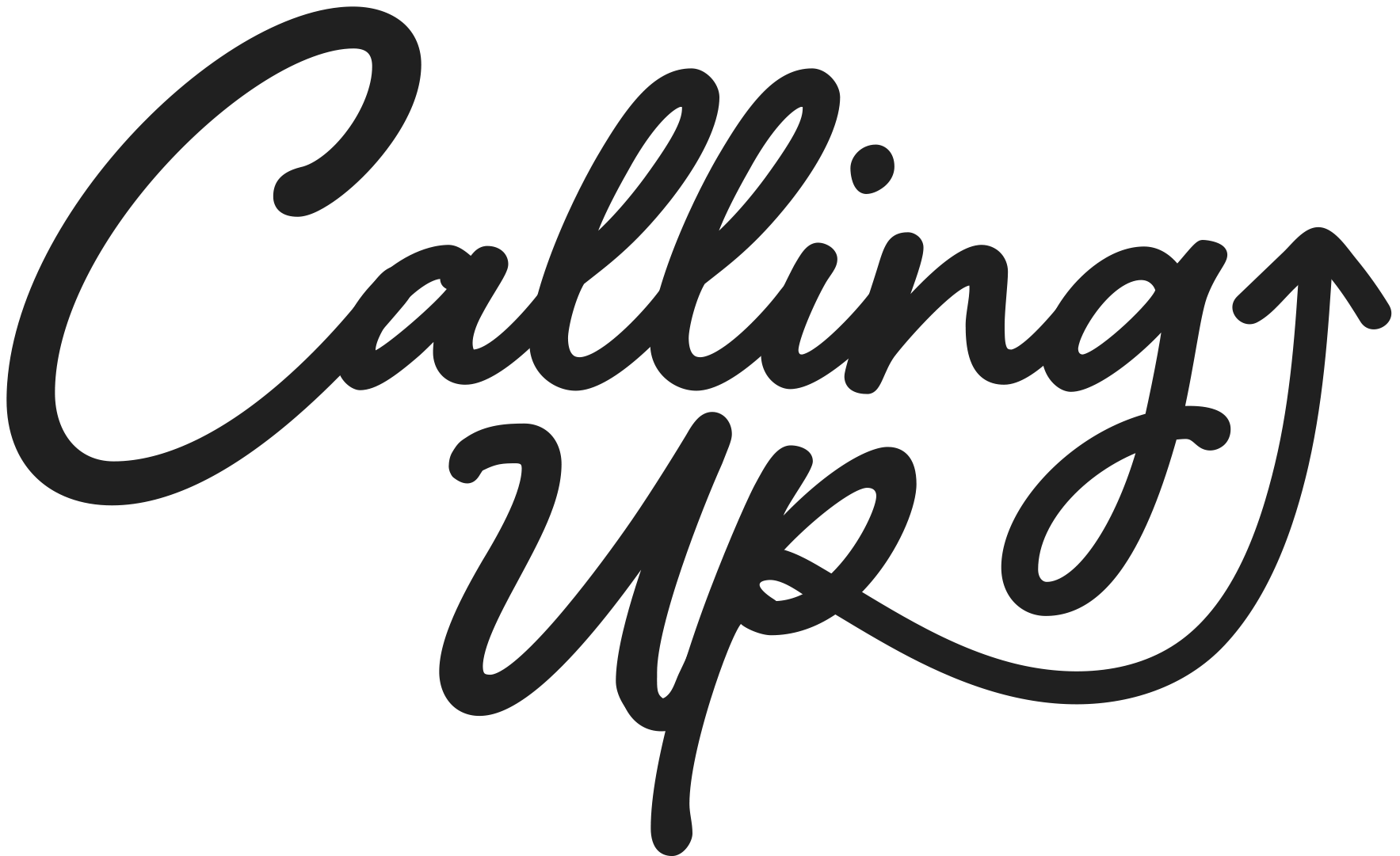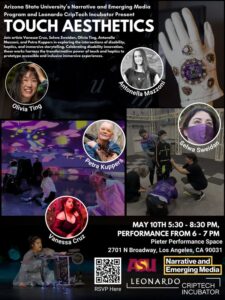So grateful for the fascinating encounters with technology and performance we were able to produce together. The fellows are all experts in their field and have created amazing and engaging projects. It’s such a pleasure to work with the CripTech Incubator. The online sessions were educational and productive. Alas Claudia was unable to attend LA in person due to health issues. She compiled an access and hospitality guide and gave the access team a mini training. Thanks to Janae for joining us as an addition to the access team as lead access doula! https://leonardo.info/civicrm/event/info
Date: May 10, 2025
Time: 5:30-8:30 PM PDT, Interactive Performance 6:00-7:00 PM
Location: Pieter Performance Space (2701 N Broadway, Los Angeles, CA 90031)
Join artists Vanessa Cruz, Selwa Sweidan, Olivia Ting, Antonella Mazzoni, and Petra Kuppers in exploring the intersections of disability, haptics, and immersive storytelling.
This event activates a set of experiments in creative access and immersive storytelling incubated in the Touch Aesthetics Fellowship, a collaboration between Leonardo CripTech Incubator and the Haptics for Inclusion Lab, under the Narrative and Emerging Media Program at Arizona State University (ASU NEM Program). Touch Aesthetics features a “crip-vibro” interactive performance and several multi-sensory VR activations that center creative access. Celebrating disability innovation, these works harness the transformative power of touch and haptics to prototype accessible and inclusive immersive experiences.
“Immersive storytelling has traditionally relied on audiovisual elements to drive the narrative. While rich, such experiences do not explore the vast sensory capacity of human bodies, and can foreclose avenues of perception for people with disabilities. Integrating touch and haptics into storytelling not only expands the audiences it can reach, but the stories that can be told.” – Vanessa Chang, Director of Programs at Leonardo/ISAST
“This fellowship has allowed me to build up on my previous research work, and continue experimentation on the creative use of haptics to enhance storytelling. Touch is the first sense we develop as humans, and it’s also the most inclusive and at the base of many experiences throughout our lives. How can it be then that touch experiences are not yet an integral part of storytelling? Despite the increase of haptics in digital entertainment, their use is limited to the same applications. Through this fellowship I’m proposing new ways to use haptics as an inclusive storytelling technique.” – Antonella Mazzoni, Touch Aesthetics Fellow
Artists and Works Featured
Petra Kuppers:
Title: Planting Disabled Futures – a virtual reality ritual
This crip intimacy installation invites you into a world of healing plants cultivated by disabled peoples’ embodied ways of knowing. Come, try out a headset, hold a plushy critter, and become entangled with the ways we as disabled people honor and engage with plant elders.
Background info: https://www.petrakuppers.com/planting-disabled-futures(link is external)
Antonella Mazzoni
Title: “Blackout”, a Haptic Tale.
Blackout is the very first prototype of Haptic Tales, a new multi-sensory story experience for ALL abilities that Antonella conceived during her Touch Aesthetics fellowship, while experimenting on the creative use of haptics as an inclusive narrative technique.
In Blackout, audiences find themselves immersed in an intimate multi-sensory adventure that invites them to reimagine storytelling through the sensations felt on their bodies.
The journey is audio narrated+captioned in a low-lit VR storyworld, and infused with custom Haptic Effects (HFX) that act as “kinesthetic onomatopoeia for our bodies”.
Olivia Ting
Title: “Field Guide to Decoding Gobbledygook”
A haptic and first-person perspective augmented reality game experience of decoding mangled words from a hard of hearing perspective.
Vanessa Hernández Cruz & Selwa Sweidan
Title: Choreographic Imaginings: Crip Haptic Flower Techno Jam
Vanessa Hernández Cruz & Selwa Sweidan have been imagining ways to use Haptics technology to create a way to expand choreographic imaginings & movement, centering the needs of Disabled dancers with the goal of developing deeper connection as a community. In collaboration with Disabled artists: Thai Lu, Lauren Brooks, 이방 Haejin, & Heidi Andrea Rhodes and our software & tech developers: Premankur Banerjee & Catherine Yunis, we have designed an exciting wearable prototype blanket and software that can be controlled in real-time, called “Crip Haptic Flower Techno Jam”. With this technology we can begin utilizing this to generate movement for choreography and/or have movement improvisation jams with Disabled artists, with hopes in the future to use across long distances.
During our time together we will have a 45min participatory performance where we invite everyone to join our journey as we guide you through our process through movement prompts, culminating in trying out our prototype.
Accessibility Information
Access is a creative practice that goes beyond mere compliance. Recognizing the disabled community is not homogenous and our needs are not identical or static, access requires communication and collaboration.
We are committed to ensuring that the building is accessible to all participants. The space is located on the 2nd floor, up one flight of stairs or via a password-protected elevator. The dance studio and restrooms are free of steps and other mobility barriers. Please note that there are no automated doors in the building.
ASL interpretation is available upon request, captioning will be provided. Please submit accommodation requests to criptech@leonardo.info at least 5 days in advance of the event to ensure we can meet your needs.
This event is presented by, with, and for the disabled community, which has been disproportionately impacted by the COVID-19 pandemic. As our community members remain vulnerable and may be continuing to shield from COVID-19, we kindly request all attendees wear masks during the event. Additionally, we ask that participants take a COVID-19 test within 24 hours before attending and bring a photo of your results to the event. Free KN95 masks, rapid COVID tests, and hand sanitizer will be available on site.
About ASU’s Narrative and Emerging Media Program
Arizona State University’s Program for Narrative and Emerging Media (NEM) in Los Angeles is a best-in-class research, teaching and gathering venue, with a focus on diversifying the demographics of who gets to create and distribute narratives using emerging media technologies in the areas of arts, culture and nonfiction. The MA’s mission is to be an inclusive, affordable professional program and a center of excellence, bringing together pioneers from diverse communities, pushing technology with underrepresented narratives, and using innovative techniques for practice and policy, all strongly anchored in ASU’s larger purpose of inclusion. NEM trains and supports storytellers, artists, journalists, entrepreneurs and engineers who are building the stories, technologies and policies of the future as leaders in the emerging media landscape. In fall 2022, we launched our flagship MA Narrative and Emerging Media, centered around the development of a creative practice and critical understanding of emerging storytelling and immersive experience content creation in augmented, virtual and extended reality, and short-form digital, streaming and virtual production. Students engage in professional networking and for-credit portfolio development, and emerge prepared to take on roles in film, content development, media production and project management, or become entrepreneurial storytellers ready to seek funding for their own projects. Our team is composed of dedicated and diverse professionals spanning fields of journalism, film and VFX effects, and art and technology.
About Leonardo’s CripTech Incubator
Leonardo CripTech Incubator is an art and technology program for disability innovation. Encompassing residencies, workshops, presentations, publications, and education, this innovation incubator creates a platform for disabled artists to engage and remake creative technologies through the lens of accessibility. Employing a broad understanding of technologies, including prosthetic tools, neural networks, software. and the built environment, CripTech Incubator reimagines enshrined notions of how a body-mind can move, look, communicate. A first-of-its-kind program in the field, the program understands access as an institutional practice.

